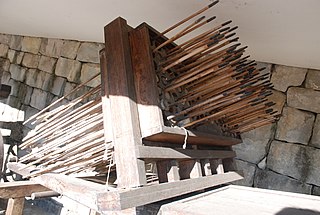 W
WDangpa, or dang pa, is the Korean name for a Ranseur first described in the Muyejebo, a Korean martial arts manual of the Joseon Dynasty.
 W
WThe Korean Bow is a water buffalo horn-based composite reflex bow, standardized centuries ago from a variety of similar weapons in earlier use. Due to its long use by Koreans, it is also known as Guk Gung. The Korean bow utilizes a thumb draw and therefore employing the use of a thumb ring is quite common. The Korean thumb ring is somewhat different from the Manchu, Mongol, or the Turkish Thumb Ring, as it comes in two styles, male and female. Male thumb rings are shaped with a small protrusion that sticks out that the bowstring hooks behind, while the female thumb ring simply covers the front joint of the thumb as protection from getting blisters.
 W
WThe gichang is a Korean weapon which is first described in the Muyesinbo, a Korean martial arts manual published in 1759. It later also found its way into the Muyedobotongji (1791).
 W
WThe Jangchang, literally long spear, is a Korean weapon first described in the 16th century martial arts manual, Muyejebo. The weapon was preferably made from the wood of the yew tree, but other types of wood could be used as well, such as oak and chestnut.
 W
WThe jukjangchang, literally bamboo long spear, is a Korean weapon.
 W
WKorean swords have served a central place in the defense of the nation for thousands of years. Although typical Korean land battles have taken place in wide valleys and narrow mountain passes, which favor use of the spear and bow, the sword found use as a secondary, close-quarters weapon, especially useful during sieges and ship-to-ship boarding actions. Higher quality, ceremonial swords were typically reserved for the officer corps as a symbol of authority with which to command the troops. Ceremonial swords are still granted to military officials by the civilian authority to this day.
 W
WThe langxian was a branched, multi-tipped spear with blades attached to the branches. The blades could be dipped in poison. The langxian was a weapon well suited for defense, as it would be difficult for an opponent to assault the wielder without risking contact with the blades.
 W
WSingijeon or shinkichon was a type of Korean fire arrow rocket, used during the era of the Joseon Dynasty (1392–1897). Multiple singijeon could be launched by hwacha.
 W
WThe woldo, was a Korean pole weapon that closely resembled the Chinese guandao, though proportionally smaller. It was so named because of its curved blade. Its use and its methods were described in the Muyedobotongji, which was published in 1795.